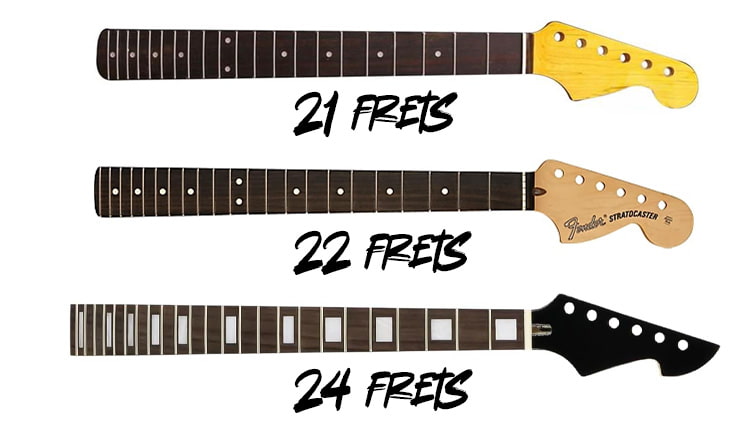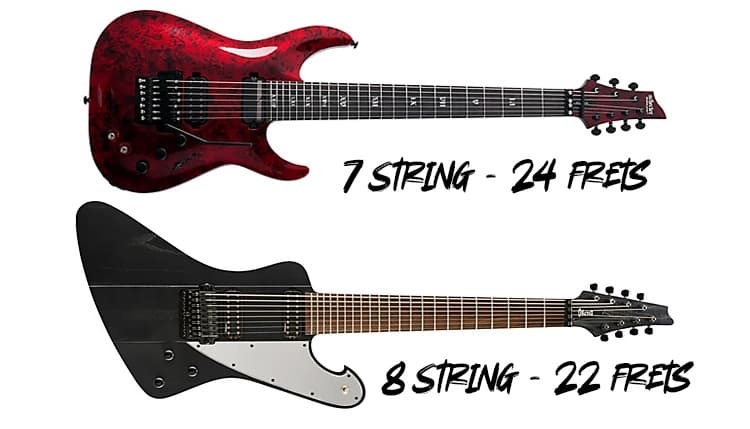As a guitar enthusiast, I’ve found myself pondering the question “how many frets are on a guitar” more times than I can count.
Did you know that the number of frets on a guitar can significantly impact its sound and playability?
Let’s dive into the fascinating world of guitar frets and unravel this mystery together!
How Many Frets are on a Guitar: The Basics
Man, when I first started playing guitar, I had no clue what those metal strips on the neck were all about. Turns out, they’re called frets, and they’re pretty darn important!
Frets are basically these thin metal bars that run across the guitar neck, dividing it into segments. They’re like the unsung heroes of the guitar world, y’know?
So, here’s the deal: frets are what give us those specific pitches when we press down on the strings. Without ’em, we’d be sliding all over the place trying to hit the right notes.
Trust me, I tried playing a fretless bass once, and it was a disaster! It’s like trying to hit a bullseye while riding a unicycle – not impossible, but definitely not for beginners.
The cool thing about frets is how they affect the pitch. Each fret represents a semitone increase in pitch as you move up the neck.
It’s like a musical staircase, with each step taking you higher in pitch. I remember when this finally clicked for me – it was like unlocking a secret code to the guitar universe!
Guitar Fret Intonation
Now, let me tell you, intonation is a big deal when it comes to frets. If your frets aren’t placed just right, your guitar’s gonna sound wonky no matter how well you play.
I learned this the hard way when I bought a cheap guitar online. The frets were all over the place, and it sounded like a cat in a blender. Not cool.
Guitar Fret History
Speaking of history, frets have been around for a while. They started showing up on stringed instruments way back in the 16th century.
Before that, people were using gut strings tied around the neck as makeshift frets. Can you imagine? Talk about a DIY approach!
Here’s a quick rundown of how frets evolved:
- Ancient times: No frets, just vibes (and probably a lot of out-of-tune notes)
- 16th century: Gut string frets start appearing
- 17th-18th centuries: Fixed metal frets become more common
- 20th century: Fret materials and designs continue to improve
It’s wild to think about how much guitars have changed over the years. I mean, we’ve gone from tying strings around the neck to precisely placed metal frets. That’s progress, baby!
Guitar Fret Temperament
One thing that blew my mind when I was learning about frets is how they’re actually slightly misplaced on purpose.
It’s called temperament, and it’s this weird compromise that makes sure all the notes sound in tune across the entire neck. Who knew being a little off could make things so right?
I gotta say, understanding frets really upped my guitar game. It’s like suddenly having a map when you’ve been wandering around lost.
You start to see patterns, understand scales better, and even improvise more confidently. Plus, it makes you sound smart at parties when you start dropping fret knowledge.
Just don’t overdo it – nobody likes a guitar know-it-all!
Standard Fret Counts for Different Guitar Types
Alright, let’s dive into the world of fret counts. It’s like comparing apples and oranges, except they’re all guitars.
When I first started exploring different guitar types, I was confused as heck about why they all had different numbers of frets.
But trust me, there’s a method to the madness!
Electric Guitar Fret Counts

Let’s start with electric guitars. These bad boys typically rock anywhere from 21 to 24 frets.
My first electric had 22 frets, and I thought that was the standard for years. Boy, was I wrong!
Turns out, 22 frets is common, but it’s not the only option out there.
Here’s a quick breakdown of electric guitar fret counts:
- 21 frets: Old school cool, found on some vintage-style guitars
- 22 frets: The “classic” count, great for most styles
- 24 frets: For when you need those extra high notes (looking at you, shredders!)
Now, some guitars go even further. One of the best electric guitars I played was a 27-fret guitar at a music store, and it felt like I was reaching into another dimension! But those are pretty rare and usually for specialized playing.
Acoustic Guitar Fret Counts
Moving on to acoustic guitars, things get a bit different. Most acoustics have fewer frets than electrics, typically around 18 to 20.
Why? Well, it’s partly due to the body shape. The body joins the neck earlier on an acoustic, which limits the number of frets you can comfortably reach.
I remember when I first really started playing acoustic guitar. I kept trying to play these high notes that just… weren’t there. Talk about a reality check!
But you know what? It made me focus more on the lower register and really develop my rhythm playing. Sometimes, limitations can be a good thing.
Classical Guitar Fret Counts
Now, let’s chat about classical guitars. These beauties usually have around 18 to 19 frets.
They’re designed for a different style of playing compared to steel-string acoustics or electrics. The wider neck and nylon strings give them a unique feel.
I tried learning classical guitar for a hot minute. Let me tell you, it’s a whole different ballgame.
The fewer frets actually made sense for the style of music. Plus, those nylon strings were way easier on my fingers. Silver lining, right?
One thing to keep in mind is that these numbers aren’t set in stone. You’ll find variations across brands and models. It’s like guitar manufacturers can’t help but mix things up!
Here’s a fun fact: the 12th fret is usually where the body meets the neck on most guitars. It’s like the halfway point of the string length, and it’s where you’ll find those handy octave harmonics. I used to use this as a reference point when I was learning my way around the fretboard.
Now, you might be wondering why electric guitars tend to have more frets. Well, it’s partly because of the cutaway design. That little scoop in the body allows you to reach those higher frets more easily. Plus, electric players often need those extra high notes for solos and fancy licks.
I gotta say, understanding the different fret counts really helped me choose the right guitar for my playing style. If you’re into blues and rock, a standard 22-fret electric might be your jam. But if you’re all about that shred life, you might want to look at 24-fret models.
Remember, though, it’s not just about the number of frets. It’s about how you use ’em! I’ve seen amazing players do incredible things with just a few frets, and I’ve seen others who have all the frets in the world but can’t string together a decent melody. It’s all about practice and creativity, my friends!
How Many Frets are on Extended Range Guitars

Okay, let’s talk about the wild world of extended range guitars. These babies are like the monster trucks of the guitar world – bigger, badder, and with more strings than you can shake a pick at!
7 String Guitar Fret Count
When I first saw a 7-string guitar, I thought, “Who needs that many strings?” Then I tried one, and… well, let’s just say I ate my words.
These guitars typically have the same number of frets as their 6-string cousins, usually around 22 to 24. But man, those extra strings open up a whole new universe of sound!
I remember the first time I played a 7-string. It was like suddenly having access to this deep, rumbling low end that I never knew I needed.
It took some getting used to, though. My fingers kept getting lost, and I swear that extra string was mocking me for weeks!
8 String Guitars Fret Count
Now, 8-string guitars? That’s when things get really crazy. These monsters usually have 24 frets, sometimes even more.
Playing one feels like you’re straddling the line between guitar and bass. It’s a trip!
Here’s a quick rundown of extended range guitar fret counts:
- 7-string guitars: Usually 22-24 frets
- 8-string guitars: Typically 24 frets, sometimes more
- Extended range acoustics: Often have fewer frets, around 20-22
Bariton Guitars Fret Count
Now, let’s talk about baritone guitars. These long-necked beauties are tuned lower than standard guitars, usually from B to B. They often have around 24 frets, but you’ll find some variations.
The cool thing about baritones is how they bridge the gap between standard guitars and basses.
I had a phase where I was obsessed with baritones. The extra scale length gives them this punchy, piano-like quality that’s just chef’s kiss.
But let me tell you, switching back to a standard guitar after playing a baritone for a while is… an experience. Suddenly everything feels tiny!
Extended Scale Length Guitars
Speaking of scale length, let’s dive into extended scale length guitars. These are like the stretch limos of the guitar world. They have a longer distance between the nut and the bridge, which affects string tension and tone.
Extended scale guitars often have the same number of frets as standard guitars, but those frets are spread out over a longer distance. This can make playing easier for some folks (hello, big hands!) but might be a challenge for others.
I once played a 30″ scale length guitar, and it felt like I was reaching across a football field to hit those low frets. But the tone? Oh man, it was worth the stretch. The low end was so tight and defined, it was like hearing my guitar in HD.
One thing to keep in mind with all these extended range and scale length guitars is that they can require some setup tweaks. The first time I tried to set up my 7-string, it was a disaster. I didn’t account for the thicker strings and ended up with action so high you could drive a truck under it!
Pro Tip: if you’re thinking about diving into the world of extended range guitars, try before you buy. What looks cool on paper might not feel right in your hands.
I’ve seen plenty of folks buy 8-strings only to realize they’re happy with six. No shame in that game – it’s all about finding what works for you!
Remember, more strings or a longer scale doesn’t automatically make you a better player. It’s just a different tool for a different job.
I’ve heard some mind-blowing music played on a standard 6-string, and I’ve heard some pretty mediocre stuff on extended range guitars.
At the end of the day, it’s all about what you do with what you’ve got!
The Impact of Fret Count on Playing Style and Technique
Let’s chat about how the number of frets on your axe can seriously shake up your playing style. It’s like having a bigger toolbox – more frets mean more notes to play with, but it also means you’ve gotta know how to use ’em!
First off, more frets can totally expand your playing possibilities. When I first got my hands on a 24-fret guitar, it was like someone had unlocked a secret level in a video game. Suddenly, I had access to these super high notes that I couldn’t reach before.
It was awesome for soloing, especially in genres like metal and fusion where those screaming high notes are all the rage.
But here’s the thing – having more frets doesn’t automatically make you a better player. I learned this the hard way when I tried to show off my new 24-fret guitar at a jam session. I kept reaching for those extra high notes, even when they didn’t fit the song. Talk about a facepalm moment!
Now, let’s flip the script and talk about guitars with fewer frets. These babies have their own set of advantages and challenges.
I remember playing an old parlor guitar with only 18 frets. At first, I felt limited, like I was missing out on a whole chunk of the fretboard. But you know what? It forced me to get creative.
With fewer frets, you really have to make each note count. It’s like writing a short story instead of a novel – you’ve got to pack a lot of punch into a smaller space. I found myself focusing more on rhythm and chord voicings, which actually improved my overall playing.
The challenges? Well, obviously, you can’t hit those super high notes. And if you’re used to using the upper frets as reference points, you might feel a bit lost at first.
But trust me, it’s not the end of the world. Some of the greatest blues and folk songs ever written were played on guitars with fewer frets.
Now, let’s talk about some famous guitarists and their fret count preferences. It’s like a window into their playing style:
- Jimi Hendrix: Often played 21 or 22-fret Stratocasters
- Eddie Van Halen: Known for his 22-fret guitars, but also used 24-fret models
- B.B. King: Famously played “Lucille”, a Gibson ES-355 with 22 frets
- Steve Vai: Often seen with 24-fret Ibanez guitars
It’s interesting to see how these legends adapted their playing to their instruments. Hendrix could make a 21-fret Strat sound like it had a million frets, while Van Halen’s tapping technique really took advantage of those extra high frets.
According to an article by Guitar World, Paul Gilbert explains that 21 fret guitars can actually deliver higher notes that a 24 fret guitar.
I remember watching a video of Steve Vai playing a 24-fret guitar and thinking, “Man, he’s using every single one of those frets!” It was like watching a master chef use every tool in the kitchen. Inspiring stuff!
Here’s a little personal anecdote: I once played a gig with a 22-fret guitar when I was used to my 24-fret axe. During my solo, I went to hit this high note… and it wasn’t there.
Talk about a moment of panic! But you know what? I improvised, bent a lower string, and it ended up sounding even better. Sometimes limitations can lead to creativity.
One thing to keep in mind is that fret count can affect your guitar’s tone. Generally speaking, guitars with fewer frets might have a warmer, more vintage sound, while those with more frets can have a brighter tone.
It’s not a hard and fast rule, but it’s something to consider.
At the end of the day, the number of frets on your guitar is just one factor in your overall sound and style. It’s like having different paintbrushes – they’re all useful, but it’s up to you to create the masterpiece.
Whether you’re rocking 18 frets or 24, what matters most is how you use them to express yourself musically.
So experiment, have fun, and find what works best for you!
Guitar Fret Materials and Construction

Alright, let’s dive into the nitty-gritty of fret materials and construction. This stuff might sound boring at first, but trust me, it can make or break your playing experience. I learned this the hard way when I bought a cheap guitar with crappy frets – my fingers were not happy!
Fret Materials
First up, let’s talk about common materials used for frets. The most popular choices are nickel-silver alloys and stainless steel.
Now, don’t let the name “nickel-silver” fool you – there’s no actual silver in there. It’s mostly copper with some nickel and zinc thrown in for good measure.
I remember when I first played a guitar with stainless steel frets. It was like my fingers were sliding on ice! So smooth, so fast.
But here’s the catch – they’re harder to work with and can wear down your strings faster. Nothing’s perfect, right?
Here’s a quick rundown of fret materials and their properties:
- Nickel-silver: Soft, easy to work with, wears down faster
- Stainless steel: Hard, long-lasting, can be slippery
- Gold: Fancy looking, soft, mostly for show
- Copper: Rare, soft, gives a warm tone
Guitar Fret Size and Shape
Now, let’s chat about fret size and shape. This is where things get really interesting. Frets come in all sorts of sizes, from skinny vintage-style frets to chunky jumbo frets. It’s like choosing between a pencil and a marker – they both write, but they feel different in your hand.
I used to think bigger was always better when it came to frets. Then I played a guitar with those thin vintage frets, and it was like a lightbulb went off. The precision! The control! It was like I could suddenly play all those delicate passages I’d been struggling with.
But here’s the thing – there’s no one-size-fits-all when it comes to fret size. It’s all about personal preference and playing style. Bigger frets can make bending easier, while smaller frets might give you more accurate intonation. It’s a trade-off, like most things in life.
Guitar Fret Maintenance
Let’s talk about fret maintenance for a sec. This is something I wish someone had told me about when I first started playing.
Frets wear down over time, especially if you’re a heavy player or use a lot of bends. And when they wear down, all sorts of problems start popping up – buzzing, intonation issues, you name it.
I learned about fret maintenance the hard way. I had this old guitar that I loved, but it started sounding off. Turns out, the frets were so worn down that it was like playing on a washboard.
A good fret job brought it back to life, and it was like falling in love with the guitar all over again.
Along with knowing how to clean your guitar, maintaining your guitar frets is essential for ensuring optimal playability and longevity of your instrument.
Here are several tips to help you keep your frets in top condition:
Regular Cleaning and Polishing
- Polish Your Frets: Use a fret guard to protect the fingerboard and polish your frets regularly. This can be done with a polishing cloth and a suitable abrasive, starting with lower grit and moving to higher grit for a smooth finish. A quick polish every few string changes can keep them shiny and improve playability
- Use Appropriate Cleaners: For deeper cleaning, consider using a silicone-free guitar cleaner or a mixture of lukewarm soapy water. Avoid harsh chemicals that could damage the fretboard finish
Fretboard Conditioning
- Condition the Fretboard: If your guitar has an unfinished fretboard, use lemon oil or a specialized fretboard conditioner sparingly. This helps hydrate the wood and prevent cracking. Apply one or two drops per few frets, ensuring not to over-condition
- Avoid Over-Oiling: While conditioning is beneficial, excessive oil can lead to buildup that attracts dirt. Only condition the fretboard every few string changes
String Maintenance
- Change Strings Regularly: Regularly changing your strings not only enhances sound quality but also reduces grime accumulation on the frets. Consider wiping down the strings after playing to remove sweat and oils that can cause rust
- Wash Your Hands: Before playing, wash your hands to minimize the transfer of oils and moisture to the strings and fretboard, which can accelerate wear
General Care Tips
- Keep It Dust-Free: Wipe down your guitar with a soft microfiber cloth after each session to prevent dust buildup, which can affect fret performance
- Proper Storage: When not in use, store your guitar in a case rather than on a stand to protect it from environmental factors that could lead to damage
- Check Hardware: During maintenance, inspect all hardware for loose screws or components and tighten as necessary. This includes checking electronics for any issues like scratchy pots
By incorporating these practices into your routine, you can maintain your guitar’s frets effectively, ensuring better sound quality and prolonging the life of your instrument.
Guitar Frets Conclusion
Whew! We’ve journeyed through the fretboard and uncovered the secrets behind how many frets are on a guitar.
Whether you’re strumming on a 20-fret classical or shredding on a 24-fret electric, remember that the number of frets is just one piece of the puzzle in creating your unique sound.
As you continue your guitar adventure, don’t be afraid to experiment with different fret counts – you might just discover a whole new world of musical possibilities!
So, pick up that guitar, run your fingers along those frets, and let the music flow. Rock on!








